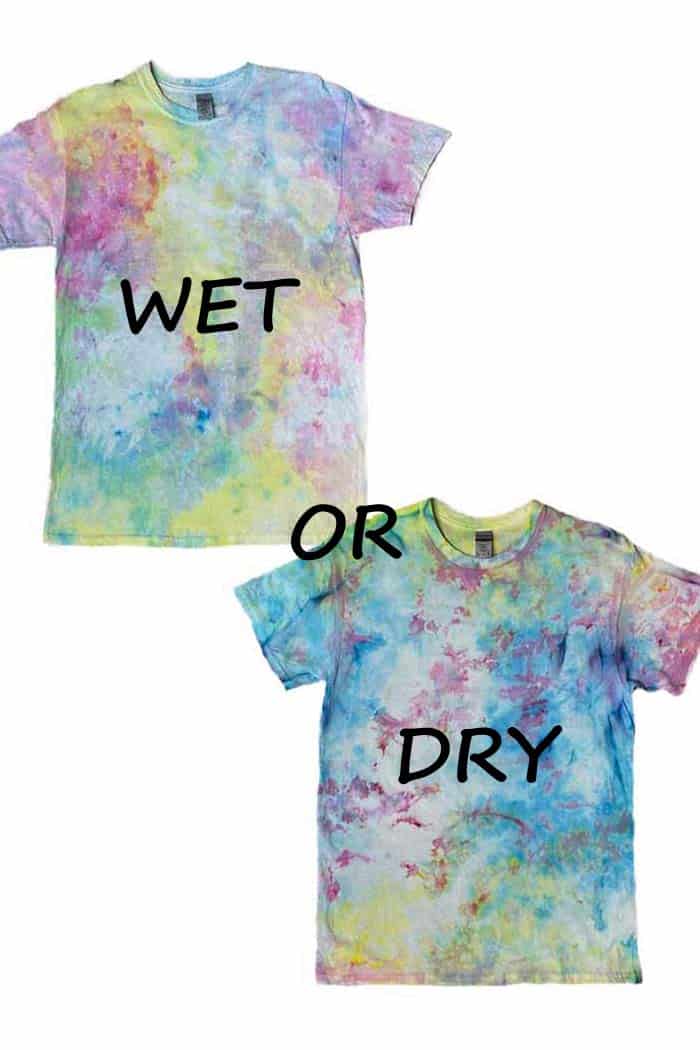How To Wash Tie Dye And Keep It Bright And Colorful

If you are creating a beautiful tie dyed item, you’ll want those colors and pattern to stay bright and last. There are several key final steps that can make or break your project: how to cure the dye and how to wash tie dye. If done right (and its easy to do), you’ll get brilliant colors. If done wrong, you’ll get muddied, muted patterns that look sad OR you’ll share that lovely dye with the rest of your clothing. Equally uncool!
Let’s break down each step to make sure that when you tie dye, each project is a success!
Start With The Right Tie Dye Supplies
Before we get into curing and washing, let’s make sure you are using the right dyes and fabrics. Not all dyes and fabrics will work with tie dye, so its important to purchase the right ones.
Types Of Dyes
Tie dyeing works best with fiber reactive dyes. They use cold water, set in the fabric (or cure) without the need for additional chemicals and produce bright popping colors. Fabric dyes like Rit, which are not fiber reactive, are best used for dyeing whole items or yards of fabric.
There are 2 types of fiber reactive dyes on the market these days:
- One Step Dyes (such as Tulip One Step Tie Dyes)
- Dyes That Require Soda Ash (such as Procion MX Dyes)
The one step dyes include soda ash in the dye, so it can be applied directly to the item in one step. The dyes requiring soda ash need the items to be soaked in soda ash for 15 minutes prior to starting to tie dye.
Personally, I spent a lot of time in college using Procion MX dyes as a textile design student and while the dye creates some nice bright colors, there are some definite downsides. While measuring and mixing the dyes we ALWAYS wore a respirator mask and worked under a large range hood for optimal ventilation. This was required because breathing in any of the powder could cause significant health issues. Since I now do all of my tie dyeing in our home, I only use the one-step dyes from Tulip since they already come in their own bottles and just require adding water. No measuring or mask required. I also like not having the added step of soaking in (and paying for) the soda ash. Oh, and the colors are still bright!
Best Items To Tie Dye
There are many items that you can tie dye. Anything made from natural fibers like cotton, linen, hemp, rayon, and silk are fair game. Ideally, the item should be 100% natural fiber, but some blends do work if the majority is natural, like an 80%/20% cotton/polyester blend. Just be aware that the colors may be slightly muted. Here is a list of 30 ITEMS YOU CAN TIE DYE with high natural fiber content.
How To Cure The Dye
The process of allowing the dye to bond with the fabric is commonly called curing or setting. It uses moisture, time, and heat and all three are important to successfully curing your tie dyed item.
Moisture
1. Once your item is fully dyed, carefully place it in the gallon plastic bag or wrap it in plastic wrap. With either method you want to seal in the moisture which helps in the bonding process. Personally I prefer the plastic bag as you can easily seal it, label it (if you are dyeing more than one item) and move it if needed without worrying about dye leaking out.
Time
2. Once in the bag or plastic wrap, let it sit for minimally 6-8 hours and up to 24 hours max, so the dye can cure. This will help produce the brightest colors. If rinsed out too early, the colors will be faded and the pattern will be harder to make out. If you leave the dye in the item longer than 24 hours, dark, odd splotches of color can appear where the fabric has dried.
HEAT
3. Last, but not least is heat and its rarely mentioned when we talk about tie dyeing projects. Why? Because most items are presumably sitting in a plastic bag/wrap in a room that is around 70 degrees. At 70-ish degrees, it takes 6-8 and up to 24 hours to cure.
The warmer the temperature, the quicker the dye will cure and the cooler the temp, the slower the dye will take to cure.
There is a new technique out there for heating the item in a microwave to cure the dye in a matter of minutes rather than hours. I have not tried this yet, but Tulip offers a very user-friendly kit if you would prefer not to wait to see your creation.
How To Wash Tie Dye
Once the dye has cured, it’s time to rinse and wash the item. This is an important step as, if done in the wrong order or rushed, it can muddy up the nice colors and pattern you created.
Hand Washing Versus Machine Washing Tie Dye
I have washed over 200 tie dyed items, at the time of writing this, and I can tell you that handwashing is by far more controlled and less messy than using the washing machine. The first part of the tie dye washing process is focused on removing all of the excess dye from the item. Unless you have an old washing machine lying around for crafts like this, I would strongly suggest hand washing.
RINSING OUT THE EXCESS DYE
1. Take the item out of the plastic bag and put it in a sink or bucket (something that can get dirty and won’t stain). We have a stainless steel kitchen sink, so I use that. You can cut/take off the rubber bands or string and then rinse it in COLD water. The cold part is critical because it allows excess dye to wash out slowly while not dyeing the remaining white parts of the item (remember that HEAT part in Curing).
2. Repeat this rinse process several times until the water is fairly clear.
3. Once the water is fairly clear, repeat the rinse process once more, but with luke warm water (not HOT). This should get the last bit of excess dye out before putting it in a washing machine.
WASHING YOUR TIE DYE
4. Once the item is thoroughly rinsed, you can wash it in the washing machine either by itself or with several other rinsed tie dye items. For example, if I’m tie dyeing a bunch of shirts, I will put up to 6 in one load. Wash on warm or cold with a bit of detergent. You can use Synthrapol (which I used in college and is commonly used for dyed items) or another regular detergent (which I do today). Either will work.
NOTE: Wash the item by itself or with other tie dye items for the next few washings before adding it in with your other clothes.
Should I Use Vinegar Or Salt On Tie Dye?
Vinegar and salt are NOT chemical fixatives that will help the dye stay in your fabric, so there is no benefit to using either of them.
Can I Wash Tie Dye In Hot Water?
Hot water is harsh on all fabrics, just like high heat. If you rinsed out your items properly in cold water and then followed up with a wash in a washing machine (on warm or cold), there is no reason to use hot water. It will not only stress out the fabric and potentially shrink or start fading the dye, but also allow the excess dye to find those white or light areas and muddy your pattern.
How To Keep Tie Dye From Bleeding
As I mentioned above, it is incredibly important to rinse out the excess dye and use cold water to do it. If you fail to rinse out the excess dye, it will run into white or light colored areas of the item (or worse, into other garments). Heat also helps dye set, so if you use hot water to rinse, it will only help any excess dye leach out and bleed into other areas of the item.
Drying Your Tie Dye
Dry the item in the dryer or let air dry. Personally I prefer air drying as it extends the life of the dye color (as they will eventually fade a bit with washing and wear).
I hope these tips will help you keep tie dyeing projects colorful and cheery for years to come.

